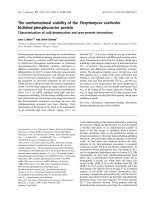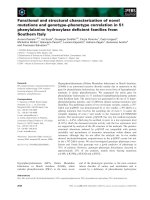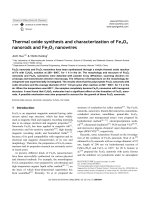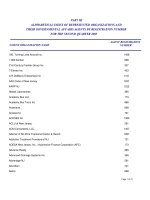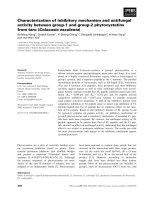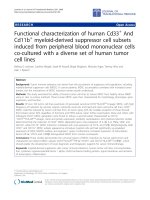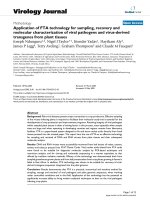Characterization of the mechanical properties of visco elastic and visco elastic plastic materials by nanoindentation tests
Bạn đang xem bản rút gọn của tài liệu. Xem và tải ngay bản đầy đủ của tài liệu tại đây (2.02 MB, 206 trang )
CHARACTERIZATION OF THE MECHANICAL
PROPERTIES OF VISCO-ELASTIC AND
VISCO-ELASTIC-PLASTIC MATERIALS BY
NANOINDENTATION TESTS
ZHANG CHUNYU
(B. Eng., National University of Defense Technology, NUDT, China)
(M. Eng., Tongji University, China)
A THESIS SUBMITTED
FOR THE DEGREE OF DOCTOR OF PHILOSOPHY
DEPARTMENT OF MATERIALS SCIENCE
NATIONAL UNIVERSITY OF SINGAPORE
2007
Acknowledgements
It is difficult to overstate my gratitude to my supervisor, A/P Zhang Yongwei, from
Department of Materials Science and Engineering of NUS, and my co-supervisor, Dr.
Wang Yuyong, from the Institute of High Performance Computing (IHPC), for their
guidance, support and encouragement. Insightful discussions with them helped me a lot
in the development of the ideas in this thesis. Their invaluable insights into the field of
mechanics of materials and their ability in explaining complicated concepts simply and
clearly inspired me to grasp the essentials of the problems. Working with them has been a
very pleasant experience.
Thanks are also given to Dr. Zeng Kaiyang from Department of Mechanical
Engineering of NUS and Ms. Shen Lu from the Institute of Materials Research and
Engineering (IMRE) for their help in preparing samples and conducting experiments.
Thanks also go to Department of Materials Science and Engineering of NUS for
providing me the scholarship, the Institute of High Performance Computing and the
Institute of Materials Research and Engineering for providing resources to do the
research.
In addition, I would like to thank my friends, Mr. Chen Li, Dr. Zhu Yanwu, Mr.
Hao Yongliang, Mr. Yin Jianhua and Dr. Man Zhenyong. Studying and working with
them will be a happy memory for my life.
I
Finally, I am forever indebted to my parents and my wife for their love,
understanding, encouragement and support throughout my life.
II
Contents
Acknowledgements Ⅰ
Table of Contents Ⅲ
Summary Ⅷ
List of Publications Ⅺ
List of Tables Ⅻ
List of Figures
ⅩⅠⅤ
1 Introduction 1
1.1 Constitutive Models 3
1.1.1 Linear Elasticity 3
1.1.2 Elasto-plasticity 4
1.1.3 Visco-elasticity 6
1.1.4 Visco-elastic-plasticity 10
1.2 Relationships between Constitutive Models and Indentation Data 13
III
1.2.1 Linear Elastic Model 13
1.2.2 Elasto-plastic Model 18
1.2.3 Linear Visco-elastic Model 20
1.2.4 Visco-elastic-plastic Model 22
1.2.5 Consideration of the Substrate Effect 23
1.3 Reverse Analysis Methodology 26
1.4 Objectives of the Study 28
References 31
2 Indentation Test 34
2.1 Experimental Apparatus 34
2.2 Samples Preparation 35
2.3 Experimental Schemes 36
3 Indentation of Homogeneous Visco-elastic Materials
Using a Flat-ended Punch
40
3.1 Visco-elastic Models 41
3.2 Analytical Solutions 43
3.3 Inverse Analysis by Genetic Algorithm 47
3.4 Experimental Verification & Discussion 48
3.5 Summary 55
References 56
IV
4 Indentation of Homogeneous Visco-elastic-plastic
Materials Using a Sharp Indenter
57
4.1 Constitutive Model 57
4.1.1 Description of the Model 58
4.1.2 Numerical Integration Scheme 60
4.1.3 Verification and Comparison with Experiments 62
4.2 Extracting the Mechanical Parameters 67
4.2.1 A Five Step Indentation Scheme to Decompose Deformations 68
4.2.2 Formulating Time-independent Plastic Deformation 69
4.2.3 Formulating Elastic, Visco-elastic-plastic Deformations 73
4.2.3.1 Concept of “Effective Indenter” 74
4.2.3.2 Analytical Solutions to Conical and Parabolic
Indentations 75
4.3 Experimental Verification and Material Parameter Extraction 79
4.3.1 Experiments Using the Five Step Scheme 79
4.3.2 Verification of the Scaling Relations 80
4.3.3 Determination of the Visco-elastic Parameters 82
4.3.4 Determination of the Plastic Parameters 89
4.3.5 Predictive Performance of the Present Model 91
4.4 Summary 95
References 96
V
5 Indentation of Visco-elastic and Visco-elastic-plastic
Films Lying on Stiff Elastic Substrates
98
5.1 Explicit Elastic Solution to a Flat-ended Punch Indentation 98
5.2 Visco-elastic Solutions to a Flat-ended Punch Indentation 106
5.2.1 Derivation of Visco-elastic Solutions 106
5.2.2 Experimental Verification 109
5.3 Dealing with Plastic Deformations in Sharp Indentations 125
5.3.1 Equivalent Visco-elastic Indentation 125
5.3.2 Analytical Solutions 131
5.3.3 Experimental Verification 134
5.4 Summary 142
Reference s 143
6 Indentation of Stiff Films Lying on Soft Substrates 145
6.1 Model Description 145
6.2 Elastic Solutions 149
6.2.1 Shallow Indentation 149
6.2.2 Moderate-depth Indentation 154
6.3 Visco-elastic Solutions 157
6.3.1 Solution to the Relaxation Test 158
6.3.2 Solution to the Creep Test 159
6.3.3 Solution to the Linear-loading Test 160
VI
6.4 Numerical Verification and Parametric Studies 161
6.4.1 Numerical Verification 161
6.4.2 Parametric Studies 164
6.5 Experimental Verifications and Discussions 172
6.5.1 Extraction of the Apparent Modulus and the Pre-stress 172
6.5.2 Extraction of the Visco-elastic Parameters 175
6.6 Summary 177
References 180
7 Conclusions and Suggestions for Future Work 182
7.1 Conclusions 182
7.2 Suggestions for Future Work 185
References 187
VII
Summary
The feasibility and efficiency of characterizing the mechanical properties of visco-
elastic and visco-elastic-plastic materials and their thin films by using nanoindentation
techniques were studied both theoretically and experimentally.
Analytical solutions were firstly derived to the flat-ended punch indentation of linear
visco-elastic materials. By combining the visco-elastic solutions and the Genetic
Algorithm (GA), an efficient reverse analysis procedure was proposed. The visco-elastic
solutions and the reverse analysis procedure were verified through shallow indentations
of polymers. It was found that the reverse analysis procedure was efficient and the
uniqueness of the reverse extraction can be checked. It was also found at least two visco-
elastic timescales were required to capture the long-time visco-deformations of polymeric
materials.
To capture the irreversible deformations of polymers in sharp indentations, a visco-
elastic-plastic model was proposed to describe the full range of deformations. The
constitutive model and its finite element implementation were verified by both uni-axial
tests and indentation tests. A five-step indentation test scheme was proposed to separate
the plastic deformation from the elastic and visco-elastic deformations. From the plastic
deformation, the plastic parameters can be determined by using two indenters with
different geometries; and from the separated elastic and visco-elastic deformations, the
visco-elastic parameters can be determined by using the concept of effective indenter. It
VIII
was shown that the mechanical parameters determined in this way were consistent with
those determined by using a flat-ended punch. In addition, the constitutive model gave a
good prediction of the indentation behaviors in other loading conditions. These findings
not only confirmed the proposed visco-elastic-plastic constitutive model and its
numerical formulation, but also confirmed the test scheme and the indentation model.
To characterize the mechanical properties of polymeric films by using flat punch
indentions and sharp indentations, the substrate effect was considered and semi-analytical
solutions were derived. It was shown that the visco-elastic properties of polymeric films
can be uniquely determined through nanoindentation tests. The results showed that the
elastic and visco-elastic properties of polymeric thin film materials are insensitive to
indentation depth; however, the viscosity is sensitive to the indentation depth due to the
influence of hydrostatic pressure.
The indentation of a pre-stressed membrane overlying a soft visco-elastic substrate
was also investigated. Analytical elastic solutions were firstly derived for shallow
indentations and then extended to moderate indentations. It was shown that the
membrane cannot be neglected in interpreting the indentation data when the size of the
indenter was comparable with a well defined length scale. This finding suggests that the
conventional Hertz theory or Sneddon’s solution may be insufficient to describe the
indentation behavior of a cell if its structure is represented by a bilayered structure on the
first-order approximation. It was further shown that the contributions from the membrane
and the soft substrate can be partitioned and their mechanical properties could be
IX
determined individually. Visco-elastic solutions were also derived from the elastic
solutions. It was found that in an indentation test, the dependence of the visco-elastic
hysteresis on the loading rate is controlled by visco-elastic time scales.
X
List of Publications
1. C.Y. Zhang, Y.W. Zhang, and K.Y. Zeng, Extracting the Mechanical Properties of a
Viscoelastic Polymeric Film on a Hard Elastic Substrate, J. Mater. Res. 19, 3053-3061
(2004).
2. C.Y. Zhang, Y.W. Zhang, K.Y. Zeng, and L.Shen, Nanoindentation of Polymers with
a Sharp Indenter, J. Mater. Res. 20, 1597-1605 (2005).
3. C.Y. Zhang, Y.W. Zhang, K.Y. Zeng, and L.Shen, Studying Visco-Plasticity of
Amorphous Polymers by Indentation Tests, IUTAM Symposium on Mechanical
Behavior and Micro-Mechanics of Nanostructured Materials, 229-238 (2005).
4. C.Y. Zhang, Y.W. Zhang, K.Y. Zeng, and L.Shen, Characterization of Mechanical
Properties of Polymers by Nanoindentation Tests, Philos. Mag. 86, 4487-4506 (2006).
5. C.Y. Zhang, Y.W. Zhang, K.Y. Zeng, L. Shen, and Y.Y. Wang, Extracting the Elastic
and Viscoelastic Properties of a Polymeric Film Using a Sharp Indentation Relaxation
Test, J. Mater. Res. 21, 2991-3000 (2006).
6. C.Y. Zhang and Y.W. Zhang, Effects of Membrane Pre-stress and Intrinsic
Viscoelasticity on Nanoindentation of Cells Using AFM, Philos. Mag., Accepted.
7. C.Y. Zhang and Y.W. Zhang, Modeling Adhesion Force in Nanoindentation of Cells
Using AFM, Submitted to J. Biomech.
XI
List of Tables
1-1 Comparison between the Laplace transforms of the field equations
for a visco-elastic problem and the field equations for its
corresponding elastic problem. 9
2-1 Specifications of MTS NANO Indenter XP. 35
3-1 Constitutive equations of the three models. 43
3-2
E
xtracted mechanical parameters of PMMA. 51
3-3
E
xtracted mechanical parameters of PET. 51
3-4
E
xtracted mechanical parameters of epoxy. 52
4-1
E
xtracted elastic-viscoelastic parameters at different values of
P
creep
/P
max
by using Sakai’s effective indenter. 82
4-2
E
xtracted elastic-viscoelastic parameters at different values of
P
creep
/P
max
by using Pharr and Bolshakov’s effective indenter. 86
5-1
B
est-fitting visco-elastic parameters of bulk PMMA using the three
m
aterial models. 111
5-2
F
itting coefficients for the three thin film systems.
i
c 114
5-3
B
est-fitting visco-elastic parameters of the 50µm-thick PMMA film
by the three visco-elastic models when the substrate is neglected. 116
5-4
B
est-fitting visco-elastic parameters of the 50µm-thick PMMA film
b
y the three visco-elastic models when the substrate is considered.
117
5-5
B
est-fitting visco-elastic parameters of the 1µm-thick GPU film
b
y the three visco-elastic models when the PET substrate is
n
eglected. 120
5-6
B
est-fitting visco-elastic parameters of the 5µm-thick GPU film by
t
he three visco-elastic models when the PET substrate is neglected. 121
5-7
B
est-fitting visco-elastic parameters of the 1µm-thick GPU film by
t
he three visco-elastic models when the PET substrate is considered.
122
XII
5-8
B
est-fitting visco-elastic parameters of the 5µm-thick GPU film
b
y the three visco-elastic models when the PET substrate is
considered. 123
5-9
R
esidual depth at different total depth of PMMA film and PC film. 136
5-10
F
itting coefficients of Eq.(5-23) at different normalized thicknesses. 136
5-11
E
xtracted parameters for the PMMA and PC films. 139
5-12 Comparison between the extracted parameters at different
i
ndentation depths.
141
6-1
E
xtracted elastic and visco-elastic parameters of the cell interior
p
hase.
177
XIII
List of Figures
1-1 (a) The Maxwell model.
(b) The Kelvin model.
7
7
1-2 (a) The generalized Maxwell model.
(b) The generalized Kelvin model.
7
7
1-3 (a) A typical visco-elastic-plastic model based on
stress-decomposition.
(b) Ghoneim and Chen’s model based on strain-decomposition.
12
12
1-4 Schematic of D-N method. 16
2-1 Schematic representation of MTS NANO Indenter XP. 34
2-2 (a) Loading profile of the indentation creep test.
(b) Loading profile of the indentation relaxation test.
(c) Loading profile of the linear loading & unloading test
without a holding segment.
(d) Loading profile of the linear loading & unloading test with a
holding segment.
(e) Loading profile of the five-step test.
37
37
38
38
39
3-1
Three generalized Kelvin models used to depict the deviatoric
deformation of polymeric materials.
42
3-2 Flowchart of the inverse analysis using GA. 49
3-3 Fitting curves of PMMA. 50
3-4 Fitting curves of PET. 50
3-5 Fitting curves of epoxy. 51
3-6 Comparison between the predicted tensile creep curve and the
experimental tensile creep curve of PMMA. 54
4-1
The constitutive model used to describe the deviatoric deformation
of polymeric materials.
59
4-2 Curve fitting and model prediction for uni-axial tests. 63
4-3
Effect of the shear yield strength
0
σ
on the load-depth curves. 65
4-4
(a) Simulated load-depth curves with a three-segment loading
history. 66
XIV
(b) Simulated loa
d
-depth curves scaled by the peak load point
)),((
maxmax
PPh at the end of the loading segment. 67
4-5
The effect of the internal friction coefficient on for k C
elasto-plastic materials.
71
4-6
The effect of
0
σ
on
0
/
σ
M . 72
4-7
The effect of
*
E
on
0
/
σ
M . 73
4-8
Schematic illustration of the replacement of an indentation on a
deformed surface with an effective indentation on a flat
surface.
75
4-9
(a) Experimental load-depth curves under a three-segment loading
history.
(b) Experimental load-depth curves scaled by the peak load
point at the end of the loading segment. )),((
maxmax
PPh
81
81
4-10
Normalization of the creep curves at different creep loading levels. 85
4-11
Good fitting was achieved by using both Sakai’s and Pharr and
Bolshakov’s effective indenter profiles. 87
4-12
The difference between of Sakai’s and Pharr and Bolshakov’s
effective indenter profiles. 88
4-13
Variation of coefficient
C
with the loading time.
90
4-14
Comparison between experimental results and simulation results
under a triangle-loading history.
93
4-15
Comparison between experimental results and simulation results
under a three-segment loading history. 94
5-1
Variation of
χ
with the normalized film thickness
RH
at
different values of
β
.
102
5-2
Comparison between
χ
and
(
)
ff
F
ν
μ
,
1
for a soft elastic film
perfectly bonded to a hard elastic substrate. 104
5-3
Comparison of
χ
and
(
)
ff
F
ν
μ
,
2
for a soft elastic film
in frictionless contact with a hard elastic substrate. 105
XV
5-4
Three visco-elastic models for the polymer film. 107
5-5
Comparison of the experimental creep curve and the fitting curves
of bulk PMMA by the three visco-elastic models. 110
5-6
Influence of the normalized film thickness
RH
on the creep
curves of PMMA films perfectly bonded to a silicon substrate. 112
5-7
Influence of
sf
μ
μ
β
=
on the creep curves of PMMA
films perfectly bonded to a hard substrate. 113
5-8
Comparison of the experimental curve and the fitting curves of the
50µm-thick PMMA film by the three visco-elastic models when
the substrate is neglected. 115
5-9
Comparison of the experimental curve and the fitting curves of the
50µm-thick PMMA film by the three visco-elastic models when
the substrate is considered. 117
5-10
Comparison of the experimental curve and the fitting curves of the
1µm-thick GPU film overlying the PET substrate by the three
visco-elastic models when the substrate is neglected. 120
5-11
Comparison of the experimental curve and the fitting curves of the
5-µm-thick GPU film overlying the PET substrate by the three
visco-elastic models when the substrate is neglected. 121
5-12
Comparison of the experimental curve and the fitting curves of the
1µm-thick GPU film overlying the PET substrate by the three
visco-elastic models when the substrate is considered. 122
5-13
Comparison of the experimental curve and the fitting curves of the
5-µm-thick GPU film overlying the PET substrate by the three
visco-elastic models when the substrate is considered. 123
5-14
The schematic of replacement of a sharp indentation by a flat-
ended punch indentation. 126
5-15
(a) Comparison between the simulated relaxation curves of a sharp
indentation on a visco-elastic-plastic film and its flat-ended punch
replacement on a visco-elastic film.
(b) Comparison between the normalized relaxation curves of a
sharp indentation on a visco-elastic-plastic film and its flat-ended
punch replacement on a visco-elastic film.
128
128
5-16
The initial load ratio of the equivalent flat-ended punch indentation
XVI
and the original sharp indentation. 130
5-17
Fitting the analytical solution with Eq. (5-21). 132
5-18
The residual depths of PC and PMMA films at different
indentation depths. 135
5-19
(a) Fitting curves of the PMMA film at depths of
m
μ
10
,
m
μ
20
and
m
μ
30
.
(b) Fitting curves of the PC film at depths of
m
μ
10
and
m
μ
20
.
138
138
5-20
Comparison of the normalized relaxation curves at different
indentation depths. 141
6-1
Schematic of the model used to study the indentation behavior of a
cell with the AFM. 146
6-2
Schematic of the indentation with a rigid sharp cone and with a
blunt cone (or with a spherical micro-bead) 148
6-3
Comparison between the shear stress
rz
σ
and the normal stress
zz
σ
at the interface between the membrane and the interior. 150
6-4 Schematic of an elastic foundation problem. 151
6-5
The plot of the variation of
(
)
cI with c. 153
6-6 Comparison of the analytical prediction by Eq.(6-5) with nonlinear
finite element simulation results at different pre-stresses. 154
6-7
The influence of on the 'scaling relationship.
0
and la ~' hP 156
6-8 Comparison between analytical solutions and numerical solutions. 164
6-9 Variation of the normalized slope of the normalized load-
indentation data with normalized pre-stress. 165
6-10 Influence of the cell interior visco-elasticity on the relaxation
curves. 167
6-11 Influence of loading rate on the load vs. depth curves of the linear
loading indentation tests. 169
6-12 Linear and sublinear indentation curves. 170
XVII
6-13
F
or polymeric materials: the hysteresis decreases with an
i
ncrease in indentation velocity; while for cells: the hysteresis
increases with an increase in indentation velocity. 171
6-14 Fitting two typical load-depth curves of red blood cells by the
present elastic model.
(a) The pre-stress of the cell membrane was considered;
(b) The pre-stress of the cell membrane was considered was
neglected.
172
173
6-15 Fitting the indentation data of chicken cardiocytes by the present
elastic model. 175
6-16 Fitting of the indentation curve of a cardiac muscle cell by the
present visco-elastic model and by Hertz model. 177
XVIII
- 1 -
Chapter 1
Introduction
Nanoindentation, also known as Depth Sensing Indentation (DSI), evolved from
early macro-indentation but has much higher resolution of load and displacement up
to nanoscale. In a typical nanoindentation test, the indenter with known geometry is
pushed into the sample material to a certain depth and then retracted. During the
whole process, both the applied load and the indentation depth are continuously
monitored and recorded by the nanoindentation system. In modern nanoindentation
systems, the indenter can be as small as tens of nanometers. Therefore,
nanoindentation is especially useful in probing thin films and small volumes of
material [1, 2]. Their mechanical properties can be extracted from the experimental
indentation data by a reverse analysis if the relationship between the mechanical
properties and the experimental indentation data is known.
Among the several types of mechanical properties, elastic property is the most
easily determined by nanoindentation because analytical solutions exist relating the
applied load, the indentation depth and the elastic modulus [3-5]. However, plastic
properties can rarely be determined by a unified approach due to the difficulty in
finding an analytical solution. As a consequence, case-by-case empirical relationships
have to be established between the plastic parameters (such as yield strength and
- 2 -
strain hardening exponent) and the indentation data [6-14]. In developing these
relationships, numerical modeling techniques, for example, finite element (FE)
method, are extensively used.
In recent years, visco-elastic and visco-elastic-plastic properties of some
important materials and structures, such as polymers, biological tissues and even
living cells, have also been investigated by nanoindentation test since the test can be
conducted in-situ in a non-destructive way [15-21]. However, compared with the
elastic and plastic properties, the visco-elastic and visco-elastic-plastic properties are
more difficult to characterize by nanoindentation techniques due to the complexity of
the constitutive relations of these materials. As a consequence, it is rather challenging
to find a concise relationship, either analytical or empirical, to relate the relatively
large number of mechanical parameters in the constitutive equations with the
experimental indentation data. Moreover, to extract these mechanical parameters,
conventional fitting techniques may be insufficient and an optimization procedure is
commonly required [16].
For visco-elastic and visco-elastic-plastic thin films, characterization of their
mechanical properties by nanoindentation techniques is even more complicated due to
the influence of substrate. To extract the “true” properties of the thin films, the
substrate effect should be considered in indentation data interpretation.
- 3 -
Characterization of the mechanical properties by nanoindentation tests usually
involves three consecutive steps: firstly, select or develop a constitutive model to
describe the mechanical behavior of sample materials; secondly, select or develop
relationships, either analytical or empirical, to establish a mapping between the
mechanical parameters in the constitutive model and the experimental indentation
data; for thin films, the effect of substrate should be incorporated in these
relationships; and finally, select or develop a reverse analysis procedure to extract the
mechanical parameters from the indentation data. These three key steps will be
reviewed in the subsequent sections in order to provide a basis for selecting existing
constitutive models and indentation interpretation methods as well as for developing
new models and methods to characterize the mechanical properties of visco-elastic
and visco-elastic-plastic materials by nanoindentation techniques.
1.1 Constitutive Models
1.1.1 Linear Elasticity
The stress-strain relation of linear isotropic elastic materials (such as metals
before yielding) can be described by the generalized Hooke’s law,
(
)
εIIIεCσ
dev
:2: GK
e
+⊗== (1-1)
where C
e
is the fourth-order tensor of elastic moduli; K, G are the bulk modulus and
shear modulus, respectively; I is the unit second-order tensor and I
dev
is the
- 4 -
fourth-order deviatoric tensor defined as
IIII
4
⊗−=
3
1
dev
in which I
4
is the
fourth-order unit tensor. Eq. (1-1) can also be written in the rate form as,
εCσ
&&
:
e
= (1-2)
and in the incremental form as,
εCσ Δ=Δ :
e
(1-3)
1.1.2 Elasto-plasticity
The metallic plasticity is often described by J
2
theory with isotropic hardening.
The key assumption of the model is that plastic flow in metals is unaffected by
hydrostatic pressure. The yield condition and plastic flow direction are based on the
deviatoric part of the stress tensor. The model can be summarized as,
(1) Decomposition of the strain tensor into the elastic and plastic components
pe
εεε += (1-4)
(2) Stress-strain relation
(
)
peee
εεCεCσ −== :: (1-5)
(3) Yield condition
(
)
(
)
0, =−=
p
Y
f
εσσ
qσ (1-6)
where
dev
σ
2
3
=
σ
is the von Mises effective stress in which
dev
σ is the
deviatoric stress tensor;
pp
ε
&
&
3
2
=
ε
is the effective plastic strain rate; and
(
)
p
Y
εσ
is the yield function.
(4) Plastic flow rule(associative)
- 5 -
nε
pp
ε
&
&
2
3
=
with
dev
dev
σ
σ
n =
(1-7)
(5) Elasto-plastic modulus
(
)
nnIIIC ⊗−+⊗= 2
γ
dev
ep
GK with
GT 31
1
+
=
γ
(1-8)
where
(
)
p
p
Y
d
d
T
ε
εσ
= .
The stress tensor for the rate-independent plasticity is usually updated using
the return-mapping algorithm. The problem of updating the stress tensor is stated as
follows: given the stress and strain at time t and a strain increment in time step Δt,
calculate the stress at time (t+Δt). In the fully implicit return-mapping algorithm, a
trial elastic stress is first calculated,
εCσσ Δ+= :
ettri
(1-9)
If the trial von Mises effective stress
tri
σ
is larger than the yield strength at time t,
i.e.,
(
)
pt
Y
εσ
, plastic flow occurs. It can be shown that at the end of the time step,
the true deviatoric stress can be written as,
()
nσ
υσ
−=
Δ+
1
3
2
tridevtt
(1-10)
where
tri
p
G
σ
ε
υ
Δ
=
3
and
(
)
()
dev
tri
dev
tri
σ
σ
n =
. The effective plastic strain increment
p
ε
Δ
can be obtained by solving the following nonlinear equation usually with
Netwon-Rampson method,
(
)
03 =Δ−Δ+−
pppt
Y
tri
G
εεεσσ
(1-11)
The material stiffness matrix (Jacobian matrix) can be derived as,
- 6 -
()
()
() ( )
nnIII
ε
σ
C
⊗−−−+⊗=
Δ∂
Δ∂
≡
υγυ
GGK
dev
a
212
lg
(1-12)
For geo-materials such as soils and rocks, internal frictional and dilatational
effects are usually significant. The J
2
theory needs extension to incorporate the effect
of hydrostatic pressure and the Drucker-Prager criterion (another criterion, i.e., the
Mohr-Coulomb criterion, is quite similar) is developed by modifying the von Mises
criterion (Eq. (1-6)),
(
)
0: =−−=
p
Y
f
εσκσ
Iσ (1-13)
where the friction coefficient, κ, is a material parameter reflecting the effect of
pressure on the yield limit.
1.1.3 Visco-elasticity
Linear visco-elasticity is usually represented by the combination of (elastic) linear
springs and (viscous) linear dashpots. The simplest visco-elastic models are the
Maxwell model (a spring and a dashpot in series, Fig. 1-1(a)) and the Kevin model (a
spring and dashpot in parallel, Fig. 1-1(b)). The former can depict simple creep
response and the latter can depict simple relaxation response. More complicated
visco-elasticity can be studied by constructing the generalized Maxwell model (Fig.
1-2(a)) or the generalized Kelvin model (Fig.1-2(b)).
